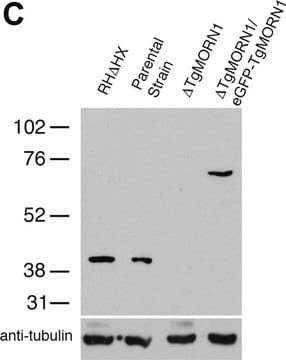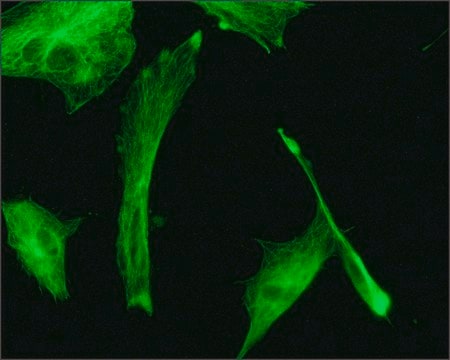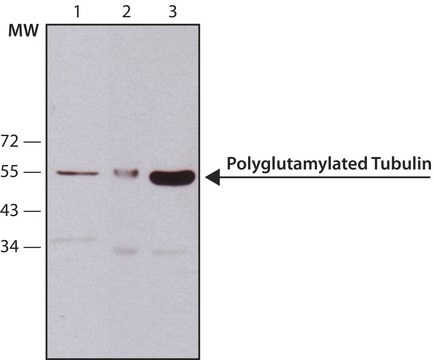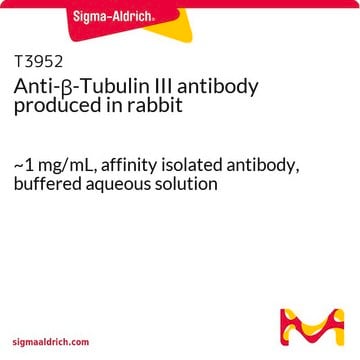Kluczowe dokumenty
T0198
Anti-β-Tubulin antibody, Mouse monoclonal
clone D66, purified from hybridoma cell culture
Synonim(y):
Łańcuch anty-tubuliny beta-1
About This Item
Polecane produkty
pochodzenie biologiczne
mouse
Poziom jakości
białko sprzężone
unconjugated
forma przeciwciała
purified immunoglobulin
rodzaj przeciwciała
primary antibodies
klon
D66, monoclonal
Formularz
buffered aqueous solution
masa cząsteczkowa
antigen ~50 kDa
reaktywność gatunkowa
human, bovine, chicken, rat, canine, Chlamydomonas reinhardtii, sea urchin (Lytechinus pictus and Paracentrotus lividus), mouse, hamster, Oxyrrhis marina (dinoflagellate), rabbit, monkey
opakowanie
antibody small pack of 25 μL
stężenie
~1 mg/mL
metody
immunocytochemistry: suitable (3% paraformaldehyde-0.5% Triton X-100 and methanol-acetone)
immunoprecipitation (IP): suitable
indirect ELISA: suitable
western blot: 0.5-1.0 μg/mL using whole extract of cultured rat adrenal pheochromocytoma (PC-12) cells
izotyp
IgG1
numer dostępu UniProt
Warunki transportu
dry ice
temp. przechowywania
−20°C
docelowa modyfikacja potranslacyjna
unmodified
informacje o genach
human ... TUBB1(81027) , TUBB2A(7280) , TUBB2C(10383)
mouse ... Tubb1(545486) , Tubb2a(22151) , Tubb2c(227613)
rat ... Tubb2(29212) , Tubb2c(296554)
Opis ogólny
Specyficzność
Immunogen
Zastosowanie
Działania biochem./fizjol.
Postać fizyczna
Oświadczenie o zrzeczeniu się odpowiedzialności
Nie możesz znaleźć właściwego produktu?
Wypróbuj nasz Narzędzie selektora produktów.
polecane
Kod klasy składowania
10 - Combustible liquids
Klasa zagrożenia wodnego (WGK)
WGK 3
Temperatura zapłonu (°F)
Not applicable
Temperatura zapłonu (°C)
Not applicable
Wybierz jedną z najnowszych wersji:
Certyfikaty analizy (CoA)
Nie widzisz odpowiedniej wersji?
Jeśli potrzebujesz konkretnej wersji, możesz wyszukać konkretny certyfikat według numeru partii lub serii.
Masz już ten produkt?
Dokumenty związane z niedawno zakupionymi produktami zostały zamieszczone w Bibliotece dokumentów.
Klienci oglądali również te produkty
Produkty
Microtubules of the eukaryotic cytoskeleton are composed of a heterodimer of α- and β-tubulin. In addition to α-and β-tubulin, several other tubulins have been identified, bringing the number of distinct tubulin classes to seven.
Nasz zespół naukowców ma doświadczenie we wszystkich obszarach badań, w tym w naukach przyrodniczych, materiałoznawstwie, syntezie chemicznej, chromatografii, analityce i wielu innych dziedzinach.
Skontaktuj się z zespołem ds. pomocy technicznej















